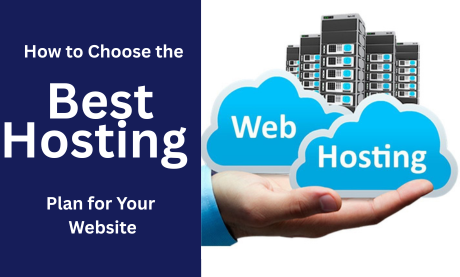Introduction
Choosing the right hosting plan is one of the most important decisions you’ll make when launching a website. It’s like choosing the foundation of your home, build it on something weak, and everything else crumbles.
Many beginners in the U.S., U.K., and across the world often rush to buy the cheapest plan they can find, only to end up frustrated by slow load times, frequent crashes, and security issues. The truth is, your hosting provider affects your website’s performance, security, SEO rankings, and even your visitors’ trust.
In this complete Beginner’s Guide on How to Choose the Best Hosting Plan for Your Website, you’ll learn everything you need to make a confident decision, no tech jargon, no confusion, just clear, actionable advice to help you pick the hosting plan that fits your goals.
1. Understanding Web Hosting Basics

Web hosting is what makes your website visible on the internet. When you buy hosting, you’re renting space on a server that stores your site’s files, images, and databases. Every time someone types your domain name, their browser connects to your host’s server to fetch your content.
Here’s a quick breakdown of the most common hosting types you’ll encounter:
-
Shared Hosting: Multiple websites share one server. It’s budget-friendly and perfect for beginners. However, if one site on the server has high traffic, it can slow down yours.
-
VPS (Virtual Private Server) Hosting: This gives you dedicated portions of a server with more resources and control. It’s great for growing businesses or websites expecting more traffic.
-
Dedicated Hosting: You rent an entire server for yourself. This gives maximum control, security, and power, ideal for large companies or eCommerce platforms.
-
Cloud Hosting: Instead of relying on one server, cloud hosting uses multiple servers to keep your site fast and reliable. It scales easily as your business grows.
-
Managed WordPress Hosting: This is a hosting plan specifically optimized for WordPress users. The host handles updates, security, and backups so you can focus on content.
2. Identify Your Website’s Needs (Problem Diagnosis)

Before signing up for any hosting plan, it’s important to define your needs. Many people buy hosting impulsively, but the smartest choice is based on knowing what your website actually requires.
Ask yourself:
-
What kind of website am I building, blog, store, portfolio, or corporate site?
-
How many visitors do I expect monthly?
-
Do I need special features such as PHP, WordPress, or eCommerce support?
-
How much storage and bandwidth do I need?
-
What’s my monthly or annual budget?
If you’re starting a small blog, shared hosting is fine. But if you’re planning a business website or online shop, invest in VPS or cloud hosting from the start.
Here is a Simple, Quick checklist:
-
Site type
-
Expected traffic
-
Budget
-
Required features
-
Target audience
This clarity helps you avoid underpowered plans that slow your site or overpriced ones that waste your money.
3. Compare the Types of Hosting Plans (Solution Options)
To make your decision clearer, here’s a quick comparison of popular hosting types:
| Hosting Type | Pros | Cons | Best For |
|---|---|---|---|
| Shared | Affordable, beginner-friendly | Slower performance, less secure | New blogs or portfolios |
| VPS | More control, scalable | Slightly technical | Growing businesses |
| Dedicated | Maximum performance, full control | Expensive | Large organizations |
| Cloud | Scalable, fast, global reliability | Can be complex | Online stores and global sites |
| Managed WordPress | Automatic updates, secure | Limited flexibility | WordPress-based sites |
4. Key Factors to Consider Before Choosing a Plan
When comparing plans, don’t focus only on the price. The cheapest option might cost you more in downtime or lost customers later. Here are the most crucial factors to check:
-
Uptime Guarantee: Choose hosts offering 99.9% uptime. This means your website will almost never go offline.
-
Speed & Performance: Go for SSD storage and a Content Delivery Network (CDN). This helps users in both the U.S. and U.K. access your site quickly.
-
Security: Your host should offer free SSL, DDoS protection, firewalls, and automatic backups.
-
Customer Support: 24/7 live chat and responsive support can save you hours of frustration.
-
Scalability: As your site grows, you should be able to upgrade easily without downtime.
-
Data Center Location: Pick a host with servers close to your audience for better speed.
-
Transparent Pricing: Check renewal rates, some hosts lure you with $2.99/month, then jump to $9.99/month later.
5. Compare Hosting Providers (Practical Evaluation)
Let’s look at top-rated hosting providers trusted globally by users in the U.S., U.K., and beyond:
-
Bluehost – Perfect for beginners. Officially recommended by WordPress and known for reliability and ease of use.
-
SiteGround – Excellent customer support and strong security, ideal for businesses and bloggers.
-
Hostinger – Budget-friendly, fast servers, and global data centers. Great for startups and small businesses.
-
WP Engine – Premium managed WordPress hosting for high-traffic sites.
-
Kinsta – Built on Google Cloud, offering speed and scalability for global reach.
6. Match Your Needs to the Right Hosting Plan
Here’s a simple guide to match your project type with the right hosting option:
-
Personal blog: Shared hosting (e.g., Bluehost Basic Plan)
-
Small business: VPS hosting (e.g., Hostinger VPS 2)
-
eCommerce website: Cloud hosting (e.g., SiteGround Cloud Plan)
-
Corporate or enterprise site: Dedicated hosting (e.g., Liquid Web or Kinsta)
If you’re unsure, go for cloud hosting, it provides flexibility, scalability, and is widely used across both the U.S. and U.K.
7. Common Mistakes to Avoid
Here are costly mistakes beginners make when buying hosting, avoid them at all costs:
-
Choosing based on price only
-
Ignoring security features and backups
-
Overlooking renewal costs
-
Picking the wrong data center location
-
Ignoring scalability and performance needs
-
Not checking real customer reviews
Always test a host’s customer service before buying. Ask a few technical questions, if they respond slowly or vaguely, that’s a red flag.
8. Step-by-Step: How to Buy a Hosting Plan
Here’s how to purchase and set up your hosting correctly:
-
Choose a provider (e.g., Bluehost, SiteGround, or Hostinger).
-
Select your hosting type (shared, VPS, or cloud).
-
Register your domain name or connect your existing one.
-
Choose a data center close to your audience.
-
Add SSL and backups (many are free).
-
Install WordPress or your CMS in one click.
-
Configure security and caching plugins (e.g., Wordfence, WP Rocket).
-
Test your site with GTmetrix or Pingdom to ensure speed.
Once done, your website will be live, secure, and ready for the world.
9. Tools to Verify Your Host’s Performance
After setting up your hosting, use these tools to keep it optimized:
-
GTmetrix: Test loading time and performance.
-
UptimeRobot: Monitor downtime automatically.
-
Pingdom: Check global speed.
-
Sucuri SiteCheck: Scan for malware.
-
Google PageSpeed Insights: Get performance scores and suggestions.
Conclusion
Make an Informed Decision
Choosing the right hosting plan is not just a technical choice, it’s a business decision. Your website’s performance, trust, and growth depend on it.
Now, I believe you understand how to choose the best hosting plan for your website, from identifying your needs and comparing providers to understanding features and avoiding traps.
Take your time to analyze, test, and choose a plan that meets your needs today and supports your growth tomorrow.
If this article helped you, share it with a friend or business owner planning to start a website. You can also subscribe to our newsletter for more practical guides on website building, SEO, and digital tools that help your business grow.

